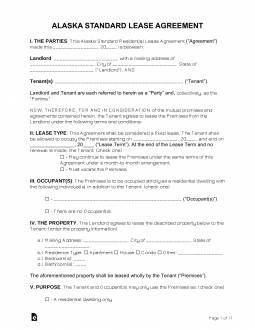Updated March 03, 2024
An Alaska residential lease agreement is a contract between a landlord that allows a tenant to occupy property in exchange for monthly rent. It is commonly written after both parties negotiate and agree to terms for a one-year agreement. Once signed, the tenant must pay the first month’s rent and security deposit (if requested by the landlord).
Required Disclosures (3)
- Absence of More than 7 Days – A clause that states if the tenant is to be absent for a period greater than seven days, the landlord must be made aware of such absence. The tenant is responsible for informing the landlord as soon as reasonably possible.[1]
- Lead-Based Paint Disclosure – The landlord must inform the tenant of the possibility of lead-based paint on the premises if built prior to 1978.[2]
- Landlord Identification – The person authorized to enter into a lease must be mentioned in the agreement.[3]
Security Deposit Laws
Maximum Amount – Two (2) months’ rent. However, if the monthly rent is more than $2,000, there is no maximum.[4]
- Collecting Interest – If a real estate broker is collecting and holding the security deposit, any interest collected must be given to the tenant at the end of the lease term.[5]
Returning to Tenant – The landlord must return the security deposit within 14 days after the tenant leaves on time. If the tenant does not leave the premises on time or in accordance with the lease, the landlord must return the deposit within 30 days.[6]
- Itemized List – For any deductions in the security deposit, such as damages to the property beyond typical wear-and-tear, the landlord must write a list of each deduction (description & amount).[7]
Separate Bank Account – The landlord must place any security deposit collected in a separate bank account. The bank account used may hold other tenants’ deposits.[8]
Rent Payment Laws
Grace Period – No rent grace period. Rent is due on the time and place mentioned in the lease.[9]
Late Fee – There is no maximum on how much a landlord can charge for late rent. Therefore, the usury rate applies, which is no more than 10.5% per year or 5 percentage points above the Federal Reserve discount rate.[10][11]
NSF Fee – If a tenant pays rent with a bad check, the fee is $30. If the tenant does not pay, the landlord may recover damages equal to $100 or triple the check amount, whichever is greater.[12]


